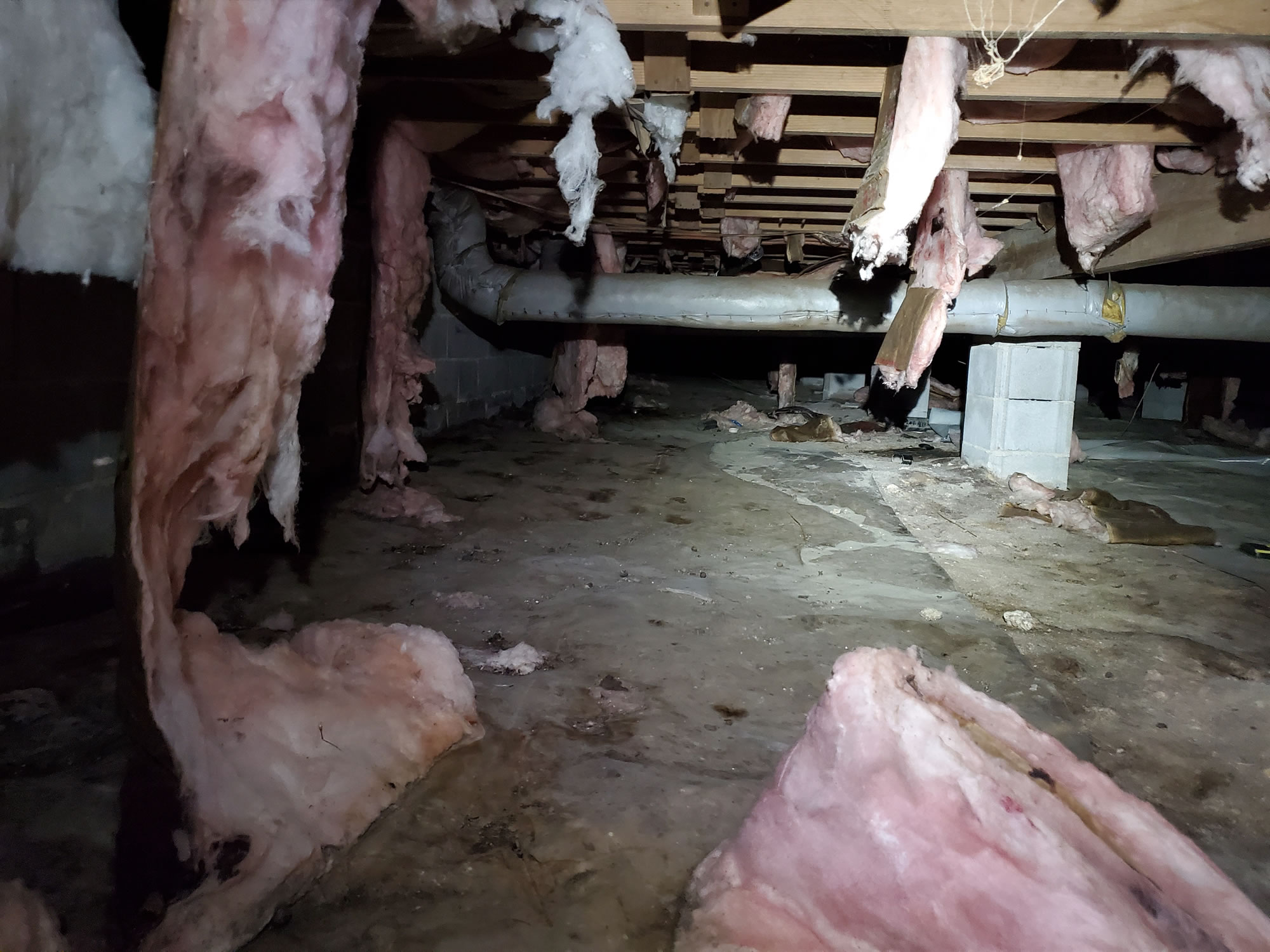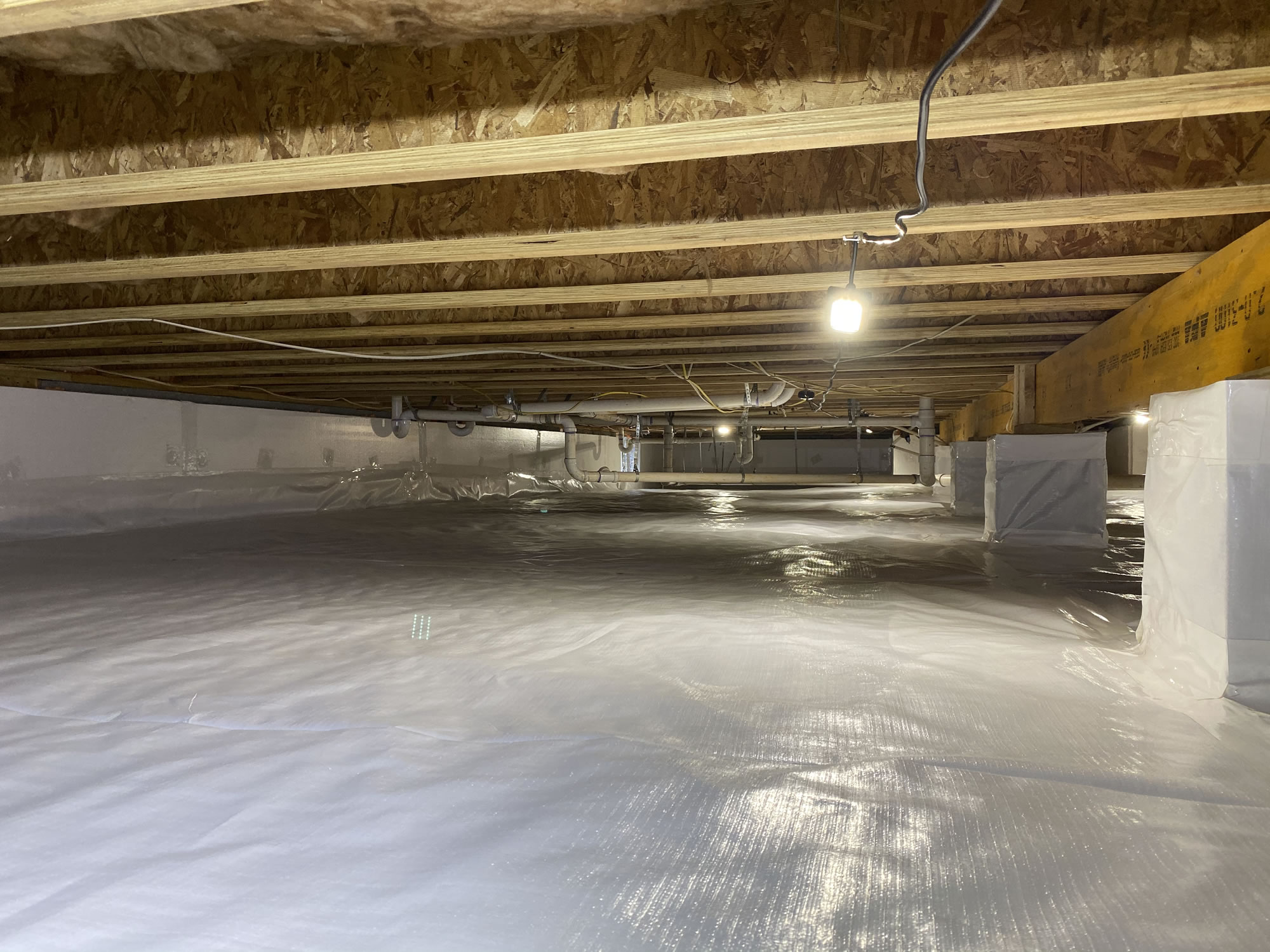We offer solutions to safeguard your home from mold and enhance indoor air quality. Our encapsulation process effectively seals your crawl space, addressing the humid climate prevalent in Cary, NC. By eliminating poor-quality air and regulating relative humidity, we prevent the growth of mold, mildew, rust, and other harmful elements.



In Cary, North Carolina’s humid climate, a vented crawl space becomes a breeding ground for mold due to factors such as high air relative humidity, limited airflow, low light, and moderate to hot temperatures. However, by effectively sealing the crawlspace and implementing environmental controls like air induction or dehumidification, we can mitigate these conditions and prevent mold growth.
Studies in building science reveal that approximately 40% of the air we breathe within our Cary homes originates from the crawlspace. Vented crawlspaces typically harbor poor-quality air laden with mold, mildew, rust, wood rot, deteriorated fiberglass insulation, pest residue, dust, pathogens, and natural vapors emanating from decaying organic matter in the soil. This compromised air infiltrates the living spaces through the stack effect and leaks in the HVAC ducts and components installed in the Cary crawlspace.
Sealing the crawlspace in your Cary, NC residence regulates relative humidity, effectively curbing the growth of mold, mildew, rust, and other harmful elements. With encapsulation, fiberglass insulation becomes unnecessary and can be removed, eliminating it as an air quality obstacle. Furthermore, encapsulation prevents pests like insects, rodents, and snakes from accessing your home. A high-quality vapor barrier provides additional protection against noxious vapors.
To combat foul odors, we apply a natural deodorization spray in your Cary crawlspace, comprising non-pathogenic bacteria and enzymes designed to consume decaying organic matter. Ultimately, a well-sealed crawlspace ensures the elimination of poor-quality air, directly enhancing the indoor air quality of your living space.

Our process commences with the installation of a polyethylene vapor barrier on the crawlspace ground of your Cary residence. We offer various options for the vapor barrier, including 10-mil, 10-mil reinforced, 12-mil reinforced, or 16-mil reinforced, all surpassing the strength of 6-mil products mandated by building codes. The vapor barrier is secured in place using heavy-gauge galvanized liner staples, meticulously rolled up at the foundation piers, and along the perimeter walls. Subsequently, it is sealed to the walls using CrawlBarrier® and taped at all foundation piers and panel seams.
Next, we mechanically fasten CrawlBarrier® to the perimeter walls of the crawlspace and meticulously tape all panel seams. To further seal the space, we utilize foam board and foam spray to seal the foundation vents.
By employing CrawlBarrier® along the crawlspace perimeter walls, we effectively seal off the space from outside air. To regulate residual moisture, we introduce either air induction or a dehumidifier as part of our conditioning process.

This approach begins by meticulously removing and disposing of the existing fiberglass insulation from your Cary, NC residence. Subsequently, we focus on air-sealing the subfloor, which acts as a barrier between the living space above and the crawlspace, ensuring all penetrations are sealed using foam spray.
Following this, we install a new polyethylene vapor barrier on the crawlspace ground, offering various options such as 10-mil, 10-mil reinforced, 12-mil reinforced, or 16-mil reinforced. The vapor barrier is securely set in place using heavy-gauge galvanized liner staples, with full roll-ups on the foundation piers and perimeters walls. These roll-ups are subsequently sealed to the walls using spray foam, along with vapor barrier tape applied to all foundation piers and panel seams.
Next, we proceed to seal the crawlspace using 2″ closed-cell spray foam, meticulously applied to the crawlspace exterior wall and rim joists. The still plate and the area 3″ below it are left exposed for future termite inspections.
Upon completion of the sealing process, we introduce air induction, a dehumidifier, or a combination of both to extract residual air moisture from the crawlspace, ensuring optimal conditions are maintained.

Option #3 follows a similar process to Option #2, albeit with a different sealing method. Instead of using 2” closed-cell spray foam, we employ BoraFoam® Rigid Foam Board to seal the crawl space walls of your Cary property.
BoraFoam® measures 2.5″ in thickness and is anchored into the crawlspace exterior wall using concrete anchors. The seams are meticulously taped with vapor barrier tape, while the edges are sealed with foam spray. Additionally, BoraFoam® is installed onto the rim joists and sealed with foam spray, leaving the still plate and the area 3″ below it exposed for future termite inspections.
This foam board is pre-treated with Borate, an anti-termite additive, and comes pre-laminated with 3-mil polyethylene vapor barrier attached on each side, totaling 6-mil accumulative thickness.
Compared to Spray Foam, BoraFoam® offers a cleaner appearance as it expands uniformly during application. Furthermore, being a cured foam board, it does not emit gases during installation, making it an ideal choice for Cary homeowners concerned about chemical exposure.
The best insulation options for crawlspaces are ones that both insulated and air seal (prevent convective heat transfer), such as rolled insulation (such as CrawlBarrier), closed cell spray foam, or rigid foam board (such as Bora-Foam). Fiberglass insulation does not air seal, so it is by far the least performing type of insulation for a crawl space
The best way to insulate a crawl space is by sealing the foundation vent openings and installing a product that will both insulate and air seal the foundation walls. This is best achieved with rolled insulation (such as CrawlBarrier), closed cell spray foam, or rigid foam board (such as Bora-Foam). This insulates the crawlspace itself and expands your home’s thermal and pressure boundary to encompass the crawl space, which provides the best environment to moderate crawl space temperature and relative humidity.
Fiberglass insulation will, on average, provide an effective service life of about 10 years before needing to be repaired or replaced. Fiberglass insulation deteriorates naturally over time and the deterioration is exacerbated in a crawl space that is subject to high relative humidity, heavy particulates in the air, and rodent / critter activity.
Insulation types that are designed to seal or encapsulate a crawl space are impermeable and made with materials that do not deteriorate over time. These include rolled insulation (such as CrawlBarrier), closed cell spray foam, or rigid foam board (such as Bora-Foam). These products will generally last the life of the crawl space and quality installers usually provide lifetime warranties against degradation or delamination.
If you live in a humid climate, crawl space encapsulation offers many benefits:
- Prohibits mold growth
- Improves indoor air quality
- Improves energy efficiency by lowering the cost to heat / cool your living space
- Protects the home’s structural integrity
- Extends the service life of crawl space installed utilities (e.g. HVAC, water heater)
- Improves your home’s resale value.
With a dehumidifier installed, TRB guarantees the performance of its encapsulated crawl spaces in terms of the ability to moderate the relative humidity and ensure against any future mold growth. TRB also offers a ‘No Mold’ Guarantee to those Customers who subscribe to TRB’s Annual Service Plan.
TRB provides a limited lifetime warranty installed CrawlBarrier insulation, closed cell Spray Foam insulation, and Bora-Foam insulation as well as on all 10-mil Reinforced or better vapor barriers. The warranty covers the costs of both labor and materials to repair or replace any degraded or delaminated products for as long as you own your home. The lifetime warranty is transferable to a buyer if on TRB’s Annual Service Plan.
Encapsulating your crawlspace will provide moderate improvement to HVAC efficiency but substantially less than you’ll achieve by improving your attic’s air sealing and insulation. The benefits of crawl space encapsulation are most notable in terms improving your home indoor air quality, protecting your home’s structural integrity, and extending the service life of your crawl space-installed utility systems (e.g. HVAC, water heater).
If your primary concern is energy efficiency, you should consider improvements in your attic before your crawl space.
Air induction uses a small amount of conditioned air from your HVAC system to help moderate crawl space temperature and relative humidity. It is lower in cost to install than a dehumidifier and is sufficient in some crawl spaces. However, air induction’s performance may be hindered by the variable conditions unique to each crawl space and is also limited to only operating when the HVAC system is running. Air induction is most challenged during the shoulder seasons of spring and fall when there may be high relative humidity in the air but the temperature is too moderate for your HVAC system to be on.
A crawl space dehumidifier costs more to install but its performance is not subject to any conditional variables or on the HVAC system. A dehumidifier will provide much more assured and consistent performance than will air induction.
Air induction may be run in conjunction with a dehumidifier as well. This will provide the assured and consistent performance of the dehumidifier as well as the air induction providing better temperature moderation and decreasing the workload on the dehumidifier which, in turn, will increase the dehumidifier’s service life.
Mold will grow in any space that has relatively high air moisture, warm to hot air, stagnant airflow, and no direct sunlight. All of these are present in crawl spaces in humid climates and why vented crawl spaces in humid climates are so susceptible to mold.
Yes. In homes with vented crawl spaces, up to 40% of the breathing air in a living space originates in the crawlspace. The is due to stack effect (the natural movement of air ‘upwards’ through your home) as well as leaks in return HVAC ducts in the crawl space.
Crawl space mold remediation is generally conducted in two ‘phases’: 1) killing the mold and 2) removing the visible, accumulated mold growth on the treated surfaces and potentially the mold staining embedded in the surface as well.
Killing mold requires the application (typically spraying or fogging) of a chemical fungicide or using a specialized process such as Dry Ice Blasting (killing mold with extremely cold temperature).
Removing the visible, accumulated growth from the treated surface is typically done with HEPA Vacuum Scrubbing, Soda Blasting (pressure cleaning with high pressure baking soda), or Dry Ice Blasting (pressure cleaning with high pressure dry ice).
Proper personal protective equipment (PPE) is mandatory. A HEPA Air Scrubber, sometime assisted by ventilation fans, is needed for all but very small remediation jobs. Any crawl space installed HVAC equipment should be turned off and left off for the duration of the remediation process.
Once mold is present, it will continue to be present and grow until it is remediated and the environmental negative conditions rectified. Mold consumes organic matter, such as wood framing in homes which will increasingly compromise the structural integrity of the home, if left unchecked

Triangle Radiant Barrier & Crawl Space Encapsulation is locally and veteran owned and operated offering residential and commercial services such as Radiant Barrier, spray foam, fiberglass insulation, solar attic fans, air-sealing, crawlspace encapsulation (including insulation, vapor barrier, dehumidification, and sump pumps), and chemical-free mold remediation options like Dry Ice Blasting and Soda Blasting.
© 2024 All Right Reserved by Triangle Radiant Barrier
Site Created by Think Designs, LLC